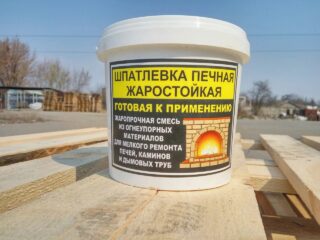Cracks on the surface of the furnace arise for various reasons, but they need to be repaired in a timely manner. A complete reconstruction is not always possible, so it is better to partially cover the stove with clay so that there are no cracks. The stove makers fill up the cracks with the same mortar on which the brick was laid. If there is no such information, and the stove is old, use standard crack repair compounds.
- The causes of cracks
- Danger of using a cracked oven
- Damage diagnostics
- How to fix the problem
- Restoration mixtures and solutions
- Fireclay putty
- Sand-clay mixture
- Ready-made adhesive mixtures for stoves and fireplaces
- Ash grout
- Plastering process
- Drying time
- Repairing cracks in metal furnaces
- Prevention of furnace cracks
The causes of cracks
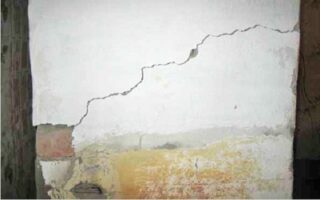
Most often, defects are laid at the stage of building the hearth. The furnace structure sags due to an incorrectly folded foundation, insufficient insulation from moisture. Cracks appear due to poor-quality masonry, poor care.
The main reasons are distinguished:
- the plaster is applied to a damp and undried surface, which is not pre-heated;
- incorrectly prepare the solution for plastering the outer walls, change the dosage of the components at their discretion;
- the boundary volume of fuel is laid, from which the insides of the hearth are very hot, and the outer part does not have time to heat up yet;
- when laying, they do not take into account the different coefficient of expansion of metal and brick, do not leave compensation gaps;
- make a small firebox that does not correspond to the level of heat load.
Cracks can be on the front surface, side walls, around the hob, around the door.
Danger of using a cracked oven
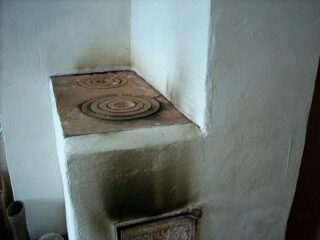
When combusted, the fuel breaks down into volatile components and solid waste. The smoke contains substances that are harmful to health, which must be removed into the chimney and taken out into the street. If there are cracks in the furnace walls, then carbon monoxide passes into the living room.
The effect of burnout on the body:
- content in the air 0.1%, breathing within an hour - a person loses consciousness;
- concentration 0.5%, staying in the room for 20 minutes - life-threatening poisoning;
- the amount in the air is about 1% - one minute is enough.
Cracks can only be on the surface, without affecting the brickwork. Carbon monoxide is not emitted into the room, but the repair of such defects is necessary. The network of small cracks in the plaster indicates the beginning of larger damage.
Damage diagnostics
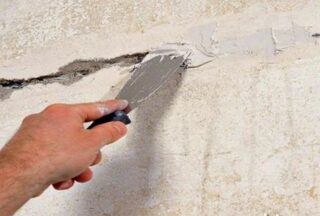
Pay attention to the state of the stove after the beginning of smoke or during a visual examination of an unmelted hearth. The number of defects is taken into account, their depth is checked with a knife blade, a thin metal ruler.
Cracks are diagnosed:
- minor damages, of which no fumes are released - you can independently repair cracks on a brickwork stove;
- large cracks from which smoke oozes - a specialist call is needed to determine the cause of the destruction of the furnace walls.
The stoves are whitewashed with lime, chalk; on such a surface, the blackness from the release of carbon monoxide is clearly manifested. You do not need to use a gas analyzer for this, defects are visible immediately. Cracks are detected not only on visible stove surfaces in the room, it is important to find damage in the body of the brick chimney, which is located in the attic area.
How to fix the problem
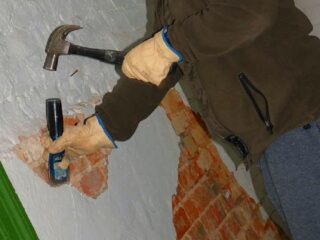
Sometimes only the plaster cracks, multiple damages are observed, but they do not affect the masonry. In this case, the layer is knocked down, the finish is re-finished. If there are few cracks, each one is repaired separately. Special grouting compounds are prepared with which you can coat a brick oven inside the house so that it does not crack.
Alternatively, use the facing of the outer area with ceramic or marble tiles:
- porcelain stoneware;
- clinker;
- tiled, tiles.
The material is durable and contributes to the integrity of the plaster layer underneath. Before laying the tiles, deep and small damages on the surface of the stove or fireplace must be repaired.
Restoration mixtures and solutions
There are certain requirements for such mixtures:
- resistance to high temperatures;
- the ability not to collapse from extremes of heat and cold;
- plastic;
- high adhesion (adhesion to the surface).
On their own, solutions for bridging cracks in a kiln between bricks or in a plaster layer are made using several components that are mixed at different concentrations, for example, include gypsum. Such mixtures are called complex. Simple grout is prepared from clay, sand. Water is used without mechanical impurities, without a greasy film on the surface.
Fireclay putty
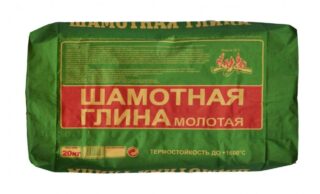
Clay is calcined kaolin. The substance gains strength, but loses its plasticity after complete removal of the liquid during sintering.
Chamotte clay qualities:
- resistant to strong heat;
- does not allow air and steam to pass through;
- environmentally friendly, does not emit impurities.
For the solution, mix M500 cement, chamotte, river sand (concentration 1: 2: 7). The components are mixed without water, then the liquid is added. The mass is made of medium density, the clay is soaked before use (1 day) to get rid of lumps.
The result is a plastic mixture that binds well to the plaster material. The solidified mass does not allow the crack to diverge in width and length.
Sand-clay mixture
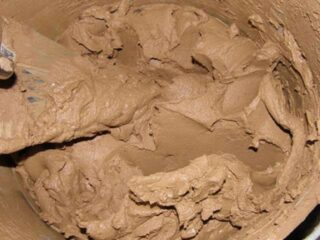
A simple mortar is an inexpensive and high-quality option for plastering and opening cracks. The solution is plastic, does not deform under heating conditions to a very hot state.
You can prepare the correct solution according to the instructions:
- clay for stove putty is kneaded in containers for a day, for soaking a bucket of substances is poured with three buckets of rainwater;
- mix the solution, knead the lumps, add another bucket of water;
- filter the mass, settle, drain the water on the surface;
- achieve a creamy state, add sand in a concentration of 1: 1.
Readiness is determined by placing the solution on the blade of a shovel. It should slide slowly, and not fall immediately or not slide at all.
Ready-made adhesive mixtures for stoves and fireplaces
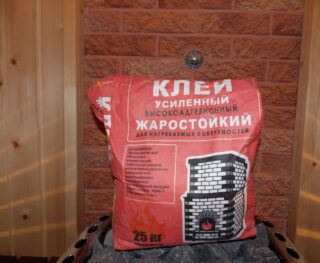
Heat-resistant compounds are sold in hardware stores. In the cured state, the adhesives stably resist heating for a long time. The composition uses chamotte clay, alabaster, refractory alumina cement.
Options for additives in ready-made mixtures:
- the filler is mineral particles of quartz sand;
- crushed chamotte, kaolin and aluminosilicate cement are added to the composition;
- glass fiber and talcum powder are used as a plasticizer.
Store-bought solutions for patching up damage quickly harden, so they are made in small portions. The package contains information about the thickness of the cracks, which can be covered with this compound. Some are used for gaps up to 3 mm, others are used for defects larger than 10 mm.
Ash grout
Allows not to use expensive materials, the quality is at the level of good factory compositions. Such mixtures were previously used everywhere, over time the number of cases has decreased, but craftsmen still use ash grout.
For the preparation of putty, materials are taken:
- slaked lime - 1 kg is needed;
- edible salt - 1 kg;
- ash - 3 kg.
Lime is placed in 10 liters of water, stirred. The resulting milk is filtered to remove lumps. Ash is passed through a sieve, mixed with salt, introduced into an aqueous solution of lime, and mixed. The sand is added until a mixture of the consistency of thickened sour cream is obtained.
Plastering process
Large and small cracks increase in size. To do this, use a spatula, chisel, hammer. The grouting will allow the grout to fill the gap as much as possible, and to fix on the masonry surface.
Sequence of work:
- primer the surface of the crack from the inside with a special impregnation or plain water;
- heat the hearth with a small amount of firewood;
- a thin layer is applied on a warm surface with a brush to create a basis for future coating;
- reinforcing mesh, rare fabric or burlap are placed on large chips.
The bulk is put in 2 layers, wait for drying and primed before applying the next one.
Drying time

It is not recommended to use the oven immediately after processing, since heating will cause the expansion of the plaster, putty, and therefore the surface will crack again. The heat-resistant ready-made solution dries up within 3 - 4 hours, the exact time is indicated on the package. The clay composition will harden for about a day.
The first firebox includes a small amount of firewood, the amount is gradually increased with each insert. You can't use full load to avoid ruining your work.
Repairing cracks in metal furnaces
Damage in iron boilers is welded, if possible. You can purchase heat-resistant paste from the store.
Putties for cast iron, steel units are made on the basis of silicone, introducing other additives:
- highly flame retardant products contain iron oxide;
- mixtures of neutral action include alcohol, which is released upon drying, gives the putty tightness;
- acid pastes are not used for metal, since they release acetic acid, which causes corrosion.
Finished products adhere well to metal, do not deteriorate at high temperatures, and are not affected by ultraviolet rays. Filled cracks withstand metal changes when heated, do not deform.
Prevention of furnace cracks
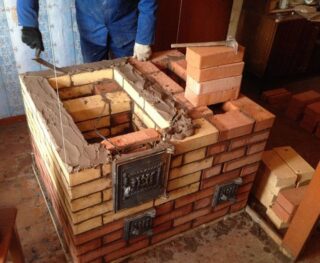
It is difficult to completely protect a folded hearth from cracking, but there are certain recommendations to reduce this likelihood.
A few tips:
- correct design and installation of the support base for the hearth;
- precise masonry in accordance with the order, replacement of metal partitions inside the furnace body with bricks on the edge;
- careful selection and preparation of plaster components, adherence to application technology.
What matters is the mode of starting the new unit, as well as the regular heating of the furnace every day. Attention is paid to the smallest cracks that appear to prevent large-scale destruction.

